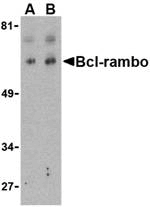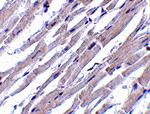Apoptosis plays a major role in normal organism development, tissue homeostasis, and removal of damaged cells. Disruption of this process has been implicated in a variety of diseases such as cancer. Members of the Bcl-2 family are known to be critical regulators of this process. These proteins are characterized by the presence of several conserved motifs termed Bcl-2 homology (BH) domains. A novel, widely expressed member termed Bcl-rambo was recently identified. This protein is localized to mitochondria in mammalian cells and its overexpression induces apoptosis which could be blocked by co-expression of inhibitor of apoptosis proteins (IAPs) such as XIAP, cIAP1, and cIAP2. Bcl-rambo shows overall homology to the anti-apoptotic members containing BH motifs, but unlike Bcl-2, the C-terminal membrane anchor of Bcl-rambo is preceded by a unique 250 amino acid insertion. This region by itself can induce apoptosis more efficiently than the Bcl-2 homology regions, suggesting that Bcl-rambo may be important other pro-apoptotic pathways.


